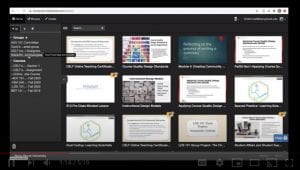 Kimberly Bell, PhD., Postdoctoral Associate
Kimberly Bell, PhD., Postdoctoral Associate
Asynchronous courses, when designed and implemented according to evidence-based research and learning theory, can be just as engaging as in-person or synchronous online courses. If you have asked yourself the following questions, or are unsure of where to start overall, this guide will introduce you to research and tips for making your asynchronous online course engaging.
- How can my students interact in an asynchronous course?
- How can I help my students give better feedback to each other in discussion boards?
- How can I give better feedback and engage students?
- How can I use group work in an asynchronous course?

Getting Started
Presence, Community, Feedback, Technology
These resources will get you started with theory and practice for engaging your students in asynchronous courses. Review the Purdue University Guide to the Community of Inquiry framework, which will introduce you to the concept of “presence” in an asynchronous course. The, dive a bit deeper and read about developing presence and learning community online, including a research study on faculty perspectives. Then, last but not least, review the ways you can give effective feedback with technology. Timely and effective feedback is a critical component of engagement.
- Guide: Purdue University Community of Inquiry Framework
- Article: Developing Learning Community in Online Asynchronous College Courses:
The Role of Teaching Presence, Online Learning Journal (OLC) - Article: Learning to Develop Presence Online: Experienced Faculty Perspectives, Journal of Adult Education
- Guide: How to Give Students Better Feedback with Technology, Chronicle of Higher Education
Learning Activities for Asynchronous Online Courses
Asynchronous, Interaction, Discussion
These three resources, activity guides from the Vanderbilt University Center for Teaching and the Center for Excellence in Teaching and Learning at the University of Rochester and the FOLD Guide to Fostering Discussion will all spark ideas for engaging activities and effective discussions you can have in your asynchronous courses.
- Guide: Interacting Asynchronously | Online Course Development Resources, Vanderbilt University
- Guide: Learning Activities for Asynchronous Online Classes, University of Rochester
- Guide: Fostering Asynchronous Online Discussion in Higher Education, FOLD
Learning Tools for Asynchronous Online Courses
Tools, VoiceThread, Discussion, Interaction
Review the resources in this collection to find tools that will help you develop and deploy asynchronous learning activities. VoiceThread is a great tool for asynchronous discussion (even in groups!). The Vanderbilt guide from the Learning Activities collection is repeated here as well, it includes both activities and tools to keep your students engaged.
- Guide: Interacting Asynchronously | Online Course Development Resources, Vanderbilt University (same as above)
- Guide: Tools for Online Asynchronous Learning, Wiley Education
- Tool: VoiceThread (asynchronous discussion tool)
Additional Teaching Tips for Asynchronous Online Courses
Active Learning, Engagement, Inclusive, Tips, Asynchronous
This collection of resources will provide you with additional tips and tricks for creating engaging asynchronous online courses. Review the IDEA guide for actively engaging students, tips specifically for inclusive teaching from the Sheridan Center for Teaching and Learning at Brown University, additional tips from Wiley, and a Faculty Focus article on fostering fun!
- Article: Actively Engaging Students Asynchronously, IDEA
- Guide: Asynchronous Strategies for Inclusive Teaching, Sheridan Center, Brown University
- Guide: Tips to Create an Engaging Asynchronous Online Learning Environment, Wiley
- Article: Fostering Fun: Engaging Students with Asynchronous Online Learning, Faculty Focus


